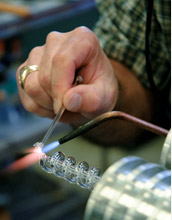Multimedia Gallery
A Glass Act (Image 2)
Gary Coyne, a scientific glassblower at California State University, Los Angles, creates a custom and coiled glass tube for a chemistry experiment. [See related image Here.]
More about this Image
Over the years, Coyne, who has worked at the University for over a quarter century and is the only scientific glassblower in the CSU system, has completed thousands of service orders--from glass hooks and coils for experiments to customized rounded-bottom flasks and cells that transmit UV rays. Coyne's glass work has been integral to many National Science Foundation-supported chemistry projects at CalState L.A., ranging from intricate custom designs critical to catalysis research, to beaker repairs that keep undergraduate labs humming.
Coyne, who holds a bachelor's degree in oceanography from Humboldt State University, got into scientific glass blowing in college, while choreographing Hungarian folk dancers. The dancer's had a number that required them to have bottles on their heads. For the bottles to stay put, though, the bottoms needed to be concave, he explained. He sought help from a chemistry professor, enrolling in the professor's glass blowing class to use his tools and complete all the bottles. Coyne discovered he had a knack for working with glass and realized that a career that combined his two interest--glass and science--would make for a bright future.
To learn more about Coyne and his glassblowing, see the Cal State L.A. Today Spring 2009 article, "A 'Glass' Act." (Date of Image: August 2009)
Credit: Bernie Kane, Public Affairs, California State University, Los Angeles
Images and other media in the National Science Foundation Multimedia Gallery are available for use in print and electronic material by NSF employees, members of the media, university staff, teachers and the general public. All media in the gallery are intended for personal, educational and nonprofit/non-commercial use only.
Images credited to the National Science Foundation, a federal agency, are in the public domain. The images were created by employees of the United States Government as part of their official duties or prepared by contractors as "works for hire" for NSF. You may freely use NSF-credited images and, at your discretion, credit NSF with a "Courtesy: National Science Foundation" notation.
Additional information about general usage can be found in Conditions.
Also Available:
Download the high-resolution JPG version of the image. (687 KB)
Use your mouse to right-click (Mac users may need to Ctrl-click) the link above and choose the option that will save the file or target to your computer.

